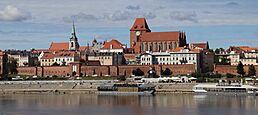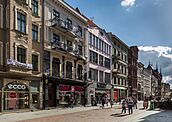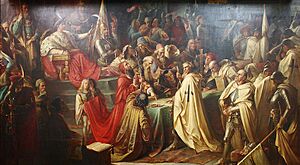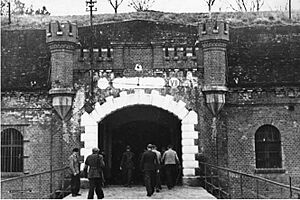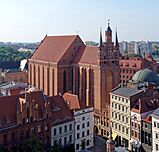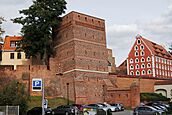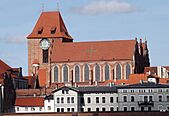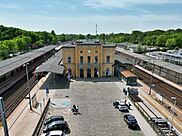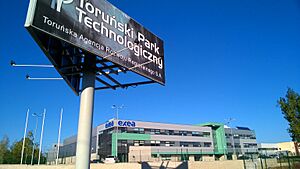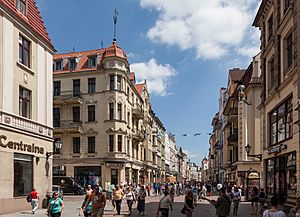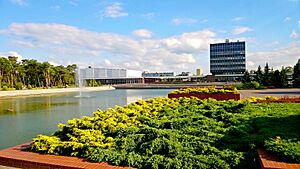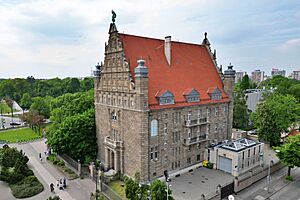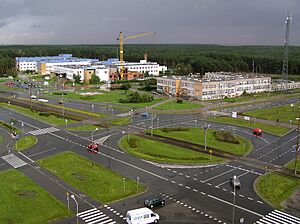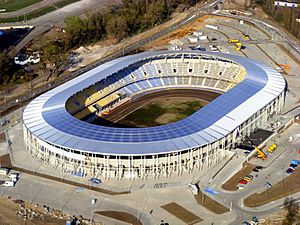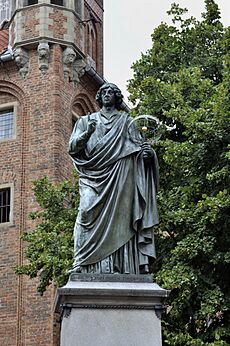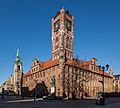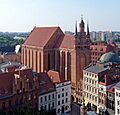Toruń facts for kids
Quick facts for kids
Toruń
|
|||
|---|---|---|---|
|
|||
|
|||
| Nickname(s):
City of Angels, Gingerbread city, Copernicus Town
|
|||
| Motto(s):
"Durabo" (Latin: "I will endure")
|
|||
| Country | |||
| Voivodeship | |||
| Established | 8th century | ||
| City rights | 1233 | ||
| Area | |||
| • City | 115.75 km2 (44.69 sq mi) | ||
| Elevation | 65 m (213 ft) | ||
| Population
(31 December 2021)
|
|||
| • City | 196,935 |
||
| • Density | 1,716/km2 (4,440/sq mi) | ||
| • Metro | 297,646 | ||
| GDP | |||
| • Bydgoszcz–Toruń metropolitan area | €10.871 billion (2020) | ||
| Time zone | UTC+1 (CET) | ||
| • Summer (DST) | UTC+2 (CEST) | ||
| Postal code |
87-100 to 87-120
|
||
| Area code(s) | +48 56 | ||
| Car plates | CT | ||
| Highways | |||
| Website | http://www.torun.pl/ | ||
| Official name: Medieval Town of Toruń | |||
| Type: | Cultural | ||
| Criteria: | ii, iv | ||
| Designated: | 1997 | ||
| Reference #: | 835 | ||
| UNESCO region: | Europe | ||
Toruń is a beautiful city in north-central Poland, located on the Vistula River. It's a special place, recognized by UNESCO as a World Heritage Site. About 197,000 people lived here in 2021. Toruń is one of the two main cities of the Kuyavian-Pomeranian Voivodeship, sharing this role with Bydgoszcz. Together, these cities and nearby areas form a large metropolitan region.
Toruń is very old, with its first settlement dating back to the 8th century. The Teutonic Knights helped it grow in 1233. For many centuries, people from different backgrounds and religions lived here. From 1264 to 1411, Toruń was part of the Hanseatic League, a group of trading cities. This made it an important place for trade, which influenced its amazing buildings, from Brick Gothic to Baroque styles.
In the past, Toruń was a very important royal city in Poland. When Poland was divided in the late 1700s, Toruń became part of Prussia. After World War I, it became part of the reborn Polish Republic. During World War II, Toruń was lucky because it was not bombed or destroyed. This means its Old Town and main market square are still original and well-preserved.
Toruń is famous for its delicious gingerbread, a tradition that is almost a thousand years old! It also has a large and impressive Cathedral. The city is known for having a very high standard of living and good quality of life. In 1997, the medieval part of the city was named a UNESCO World Heritage Site. In 2007, the Old Town of Toruń was even added to the list of Seven Wonders of Poland.
Contents
- Discover Toruń's History
- Explore Toruń's Sights
- Toruń's Districts
- Toruń's Symbols
- Toruń's Climate
- Population and Growth
- Getting Around Toruń
- Toruń's Economy
- Culture in Toruń
- Education in Toruń
- Healthcare in Toruń
- Media in Toruń
- Sports in Toruń
- Famous People from Toruń
- Toruń's International Friends
- Images for kids
- See also
Discover Toruń's History
Toruń has a long and interesting past, going back thousands of years.
Early Beginnings and Medieval Times
Archaeologists have found signs of people living near Toruń as early as 1100 BC. Later, from the 7th to 13th centuries, an old Slavic settlement was here, right by a crossing point on the Vistula River. In the 10th century, it became part of the new Polish state.
In 1231, the Teutonic Knights built a fortress nearby. On December 28, 1233, they officially founded the cities of Toruń and Chełmno. This gave the cities special rights, known as Kulm law. Because of floods, Toruń was moved to its current location in 1236. Religious groups like the Franciscan friars and Dominicans soon settled here. In 1264, a "New Town" was created next to the "Old Town" for growing numbers of craftspeople.
By 1280, Toruń joined the Hanseatic League, a powerful group of trading cities. This made it a very important trade center in the Middle Ages.
In the 14th century, there were disagreements with the Teutonic Knights. Poland briefly took back the city in 1410 during a war, but it returned to the Knights in 1411. In the 1420s, Polish King Władysław II Jagiełło built Dybów Castle near Toruń.
In 1440, local nobles and citizens formed the Prussian Confederation to oppose the Knights. This led to the Thirteen Years' War. The people of Toruń were so angry with the Knights that they destroyed their castle, brick by brick! In 1454, Toruń officially became part of the Polish Kingdom. The city's citizens swore loyalty to the Polish king, Casimir IV Jagiellon. During this war, Toruń helped the Polish army financially. The Old and New Towns joined together in 1454. The war ended in 1466 with the Second Peace of Thorn, which confirmed Toruń as part of Poland. The Polish king gave the city many special rights.
Important Times in Toruń's Development

In 1473, the famous astronomer Nicolaus Copernicus was born in Toruń. In 1500, the "Tuba Dei," a huge church bell, was put in Toruń Cathedral. A long wooden bridge was also built across the Vistula River. By 1506, Toruń was a royal city of Poland.
In 1557, during the Protestant Reformation, Toruń became a Protestant city. However, in 1595, Jesuits arrived to promote the Counter-Reformation, and religious tensions grew. In 1645, a special meeting called Colloquium Charitativum was held in Toruń. It brought together Catholics, Lutherans, and Calvinists to talk about their beliefs, which was very important for religious understanding in Europe.
During the Great Northern War (1700–21), Swedish troops attacked the city. In the early 1700s, about half the people in Toruń were German-speaking Protestants, and the other half were Polish-speaking Roman Catholics.
Modern History and World War II
In 1793, Toruń became part of Prussia. It was briefly Polish again from 1807 to 1815, even serving as a temporary capital in 1809. When it returned to Prussia, the city faced efforts to make people speak German, but Toruń became a strong center of Polish resistance. After World War I, Poland became independent again, and Toruń returned to Poland.
During World War II, Germany took over Toruń from 1939 to 1945. Many Polish people faced arrests, forced removal from their homes, forced labor, and executions. The Germans also set up a prisoner-of-war camp called Stalag XX-A and a transit camp for Poles forced out of their homes. Over 12,000 Poles passed through this camp, and about 1,000 died there, including many children.
Despite these hardships, Toruń was not damaged by fighting or bombing during the war. This is why its historic buildings, from Gothic to Baroque styles, are still standing today, looking much as they did centuries ago.
Explore Toruń's Sights
Toruń is famous for its many old buildings, especially those from the Middle Ages. The city's original medieval layout is still mostly intact, and many Gothic buildings made of brick, like churches, the Town Hall, and houses, are beautifully preserved.
Amazing Gothic Architecture
Toruń has the most preserved Gothic houses in Poland. Many still have original Gothic wall paintings or wooden ceilings from the 16th to 18th centuries.
- The Cathedral of SS. John the Evangelist and John the Baptist: Built in the 14th and 15th centuries, it has amazing Gothic sculptures and paintings. You can also see the "Tuba Dei," one of the largest medieval church bells in Europe.
- St. Mary's Church: A large church built in the 14th century, once belonging to the Franciscans.
- St. James the Greater's Church: A beautiful church from the 14th century with impressive wall paintings.
- The Old Town Hall: First built in 1274, then rebuilt and expanded. It's considered one of the most impressive town halls in Central Europe. It now houses the Toruń Regional Museum.
- City Walls: Started in the 13th century, these walls once protected the city. Most were taken down in the 19th century, but some parts remain, including gates and watchtowers like the famous Leaning Tower.
- Copernicus' House: A 15th-century Gothic house, now a museum, where the famous astronomer was supposedly born.
- Ruins of the Teutonic Knights' castle: You can still see parts of the 13th-century castle that the citizens destroyed.
- House at the Sign of the Star (Kamienica Pod Gwiazdą): This beautiful house, now an East Asian Museum, has a richly decorated front and a wooden spiral staircase.
Because Toruń was not destroyed in World War II, its Old Town is very special. All its important buildings are original, not rebuilt copies. In recent years, many buildings have been restored, and the streets and squares have been improved to look more historical. At night, many buildings and the city walls are lit up, making the Old Town look truly magical.
Toruń also has a Zoo and Botanical Garden, which are popular places to visit.
Toruń's Districts
Toruń is divided into 24 administrative areas called districts or boroughs. Each district has some control over its own local government. Some of these districts include Barbarka, Bielany, Bielawy, and the historic Stare Miasto (Old Town).
Toruń's Symbols
The official colors of Toruń are white and blue, arranged horizontally with white on top. The city's flag is a sheet with a white upper field and a blue lower field. There is also a version of the flag that includes the city's coat of arms.
Toruń's Climate
Toruń has a climate that changes a lot, influenced by both the milder weather from the west and the more extreme weather from the east of Poland. This means it has warm summers and cold winters, but they are usually not as extreme as in some other parts of Poland. The city gets a moderate amount of rain throughout the year.
Population and Growth
Recently, Toruń's population has slightly decreased. This is due to people moving to bigger cities or to areas outside the city center. It also reflects a general trend of population decline in Poland. However, the city and its surrounding areas, including Bydgoszcz, form a large metropolitan area with a total population of about 800,000 people.
Getting Around Toruń
Toruń has greatly improved its transport system in recent years. New roads, a second bridge, and better cycling paths have made traffic much smoother.
The city has a good public transport system with five tram lines and about 40 bus routes. These cover the city and some nearby towns. Toruń is also an important road hub in Poland. The A1 highway passes by, and other major roads run through the city.
Toruń is a key railway junction with three main stations: Toruń Główny, Toruń Miasto, and Toruń Wschodni. These connect the city to places like Warsaw, Bydgoszcz, Wrocław, and Olsztyn. There's a special "BiT City" rail connection between Toruń and Bydgoszcz, making it easy to travel between the two cities with one ticket.
There are also two bus stations that connect Toruń to other towns and cities across Poland. While Toruń has a small sports airfield, the main airport for the region is Bydgoszcz Ignacy Jan Paderewski Airport, about 50 km away, offering flights to European cities.
Toruń's Economy
Even though Toruń is a medium-sized city, some large Polish companies have their main offices or branches here. The city's unemployment rate is quite low.
In recent years, new factories and businesses, especially from Japan, have been built near Toruń. These are in a special economic zone and are creating many new jobs.
Tourism is a big part of Toruń's economy. More than 1.5 million tourists visit each year to see its beautiful historic buildings. The city is investing a lot in restoring its monuments, building new hotels, and creating more cultural events to attract even more visitors.
Toruń has also seen a lot of new construction, especially homes and improvements to its transport network. This has been helped by money from the European Union. The city is building many new homes each year, more than any other area in its region. Many big projects are planned or underway, including a new speedway stadium, shopping centers, a music theater, and facilities for the Nicolaus Copernicus University.
Culture in Toruń
Toruń has several theaters, including the Teatr im. Wilama Horzycy and children's theaters like Baj Pomorski. The city hosts an international theater festival called "Kontakt" every May. The Baj Pomorski building was recently rebuilt with a unique design, looking like a giant chest of drawers. Toruń also has two cinemas.
There are over ten major museums in Toruń that tell the story of the city and its region. The "House of Kopernik" museum celebrates Nicolaus Copernicus and his amazing discoveries. The university museum shares the history of the city's academic past.
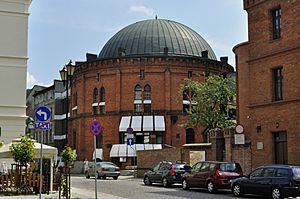
The Tony Halik Travelers' Museum was created in 2003. It displays items from different countries and cultures, donated by the wife of famous explorer and writer, Tony Halik, who was from Toruń.
The Centre of Contemporary Art (Centrum Sztuki Współczesnej - CSW) opened in 2008 and is an important art center in Poland. Toruń also has its own Symphonic Orchestra.
You can visit a planetarium in downtown Toruń and an astronomical observatory in the nearby village of Piwnice. This observatory has the largest radio telescope in Central Europe.
Toruń is very famous for its gingerbread, which is often made in special molds. There's a Museum of Toruń Gingerbread and workshops like the Living Museum of Gingerbread where you can learn to make it yourself. Even the famous composer Fryderyk Chopin loved Toruń gingerbread when he visited in 1825!
Education in Toruń
Toruń has many elementary, primary, and high schools, as well as private schools.
The biggest university in Toruń is the Nicolaus Copernicus University in Toruń. It has over 20,000 students and was founded in 1945. Having such a large and well-known university makes Toruń an important city and brings a lot of young people and energy to its streets and clubs. It also helps the local economy.
Other public colleges and universities in Toruń include a Teacher Training College and a College of Social Work. There are also several private higher education schools, such as the WSB Merito University and the University of Social & Medial Culture.
Toruń is also home to one of the oldest high schools in Poland, I Liceum Ogólnokształcące im. Mikołaja Kopernika, which started as a school in 1568.
Healthcare in Toruń
Toruń has six hospitals that provide medical care for the city and the surrounding region. The two largest hospitals are becoming part of the Nicolaus Copernicus University, serving as its clinical units for teaching and research. There are also many other healthcare facilities available in the city.
Media in Toruń
Toruń has various media outlets to keep its citizens informed and entertained.
- Newspapers and Magazines: You can find daily newspapers like Gazeta Wyborcza Toruń and Nowości, as well as weekly magazines.
- Radio Stations: Several radio stations broadcast in Toruń, playing a mix of international and Polish music, news, and religious programs. These include Polskie Radio, Radio ESKA, Radio GRA, and Radio Maryja.
- TV Stations: Toruń has regional offices for national TV channels like TVN and TVP Info. There are also local TV stations such as Telewizja Trwam and Telewizja Kablowa Toruń.
Sports in Toruń
| Club | Sport | League | Trophies |
|---|---|---|---|
| KS Toruń | Speedway | Ekstraliga | 4 Polish Championships |
| KS Toruń HSA | Ice hockey | Polska Hokej Liga | 1 Polish Cup (2005) |
| Twarde Pierniki Toruń | Men's basketball | Polish Basketball League | 1 Polish Cup (2018) |
| Katarzynki Toruń | Women's basketball | Basket Liga Kobiet | 0 |
| Pomorzanin Toruń | Men's field hockey | Superliga | 3 Polish Championships |
| Anioły Toruń | Men's volleyball | II liga | 0 |
| Elana Toruń | Men's football | III liga | 0 |
| Pomorzanin Toruń | Men's football | IV liga | 0 |
| FC Toruń | Men's futsal | Ekstraklasa | 0 |
Toruń is home to several professional sports teams. Speedway, a type of motorcycle racing, is very popular, with the KS Toruń team having won multiple Polish Championships. The city also has teams for ice hockey, men's and women's basketball, field hockey, volleyball, and football. The MotoArena Toruń is a modern stadium for speedway events.
Other notable sports clubs include the Angels Toruń for American football and Nestle-Pacyfic for cycling. The E11 European long distance path for hikers also passes through Toruń.
Famous People from Toruń
Many important people were born or lived in Toruń:
- Nicolaus Copernicus (1473–1543), a brilliant scientist and astronomer who changed our understanding of the universe.
- Anna Vasa of Sweden (1568–1625), a Polish and Swedish princess.
- Samuel Linde (1771–1847), a famous linguist who created a dictionary of the Polish language.
- Fryderyk Skarbek (1792–1866), an economist and writer.
- Frédéric Chopin (1810–1849), a world-famous composer and pianist, visited his godfather here.
- Elżbieta Zawacka (1909–2009), a university professor and a brave freedom fighter during World War II.
- Tony Halik (1921–1998), a film operator, documentary maker, and explorer.
- Aleksander Wolszczan (born 1946), an astronomer who discovered the first planets outside our solar system.
- Bogusław Linda (born 1952), a well-known actor.
- Michał Kwiatkowski (born 1990), a successful road bicycle racer.
Toruń's International Friends
Toruń has special relationships with cities around the world, called twin towns or sister cities.
Honoring its friendship with Philadelphia, Pennsylvania in the United States, a long street along the Vistula River is named Bulwar Filadelfijski (Philadelphia Boulevard).
Another street, Ślimak Getyński, is named after Göttingen, Germany. Its name comes from its half-circular shape, as ślimak means "snail" in Polish.
Twin Towns and Sister Cities
Toruń is twinned with:
 Philadelphia, Pennsylvania, United States, since 1977
Philadelphia, Pennsylvania, United States, since 1977 Göttingen, Lower Saxony, Germany, since 1978
Göttingen, Lower Saxony, Germany, since 1978 Leiden, South Holland, Netherlands, since 1988
Leiden, South Holland, Netherlands, since 1988 Hämeenlinna, Finland, since 1989
Hämeenlinna, Finland, since 1989 Čadca, Slovakia, since 1996
Čadca, Slovakia, since 1996 Swindon, Wiltshire, United Kingdom, since 2003
Swindon, Wiltshire, United Kingdom, since 2003 Novo Mesto, Slovenia, since 2005
Novo Mesto, Slovenia, since 2005 Lutsk, Ukraine, since 2008
Lutsk, Ukraine, since 2008 Guilin, China, since 2010
Guilin, China, since 2010
Images for kids
-
Copernicus' House, currently a museum
-
Birthplace and house of Polish economist and writer Fryderyk Skarbek, residence of his godson Fryderyk Chopin in 1825
-
Józef Piłsudski Bridge over the Vistula River
See also
 In Spanish: Torún para niños
In Spanish: Torún para niños


